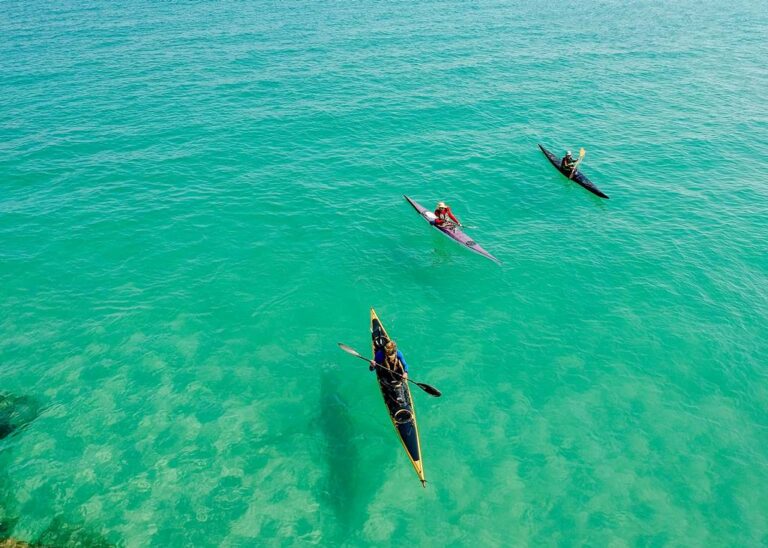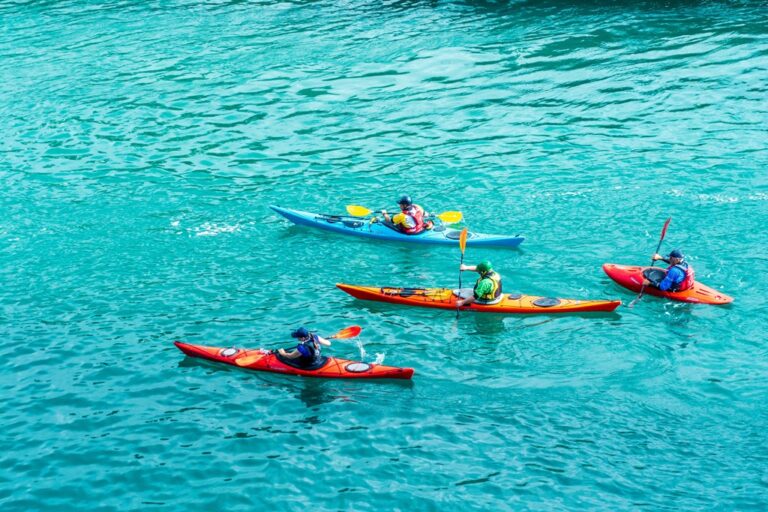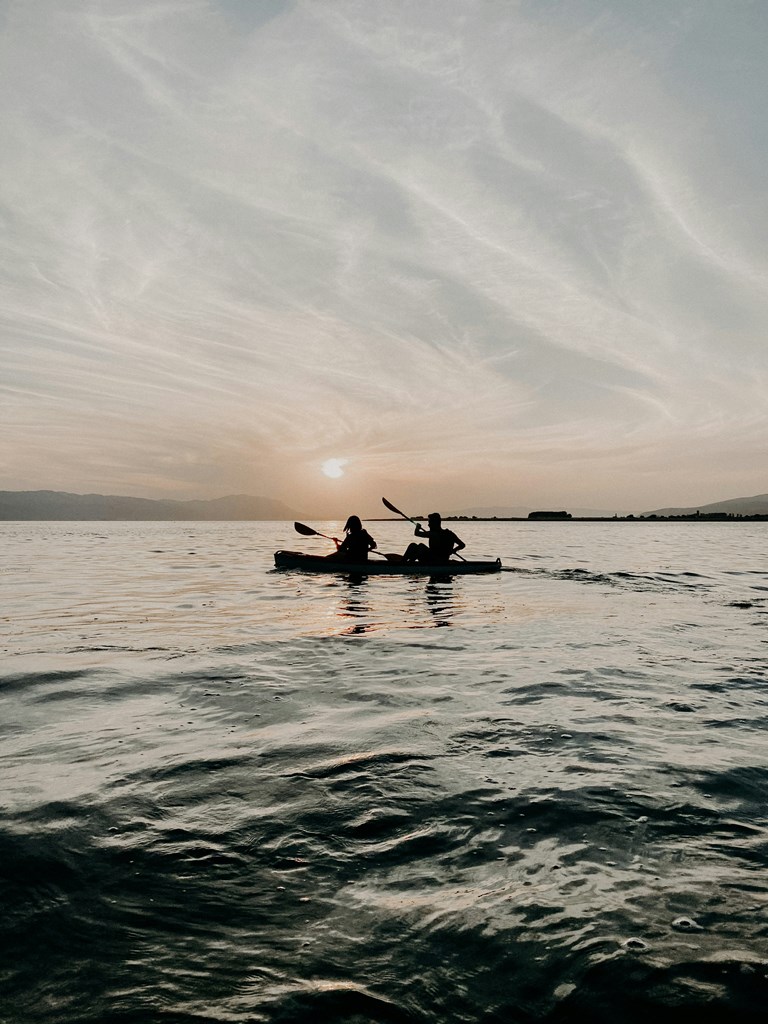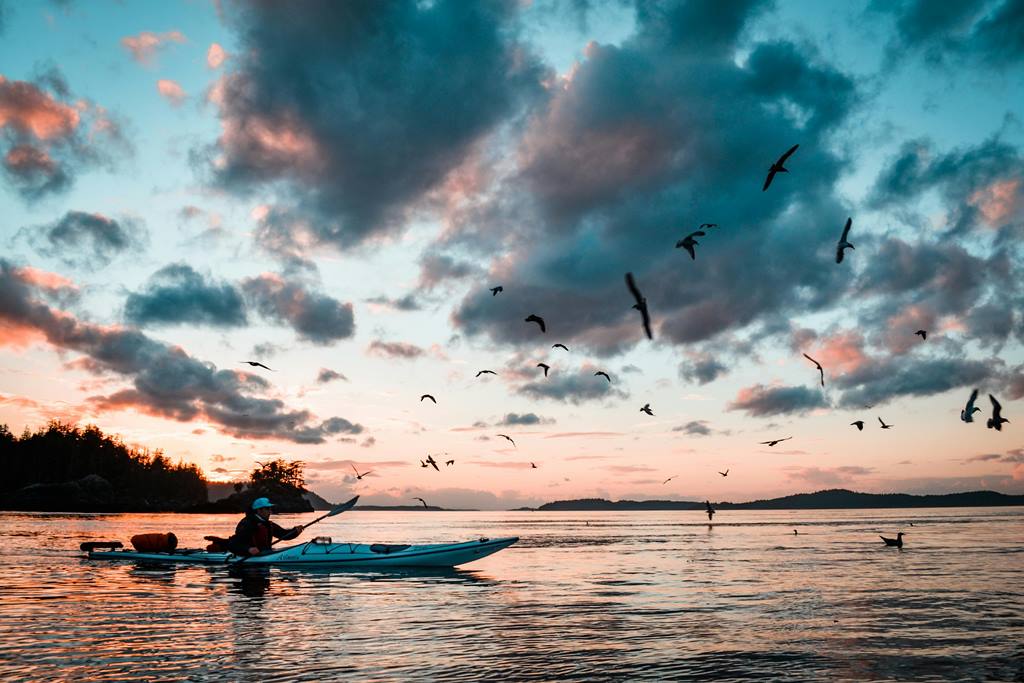
Imagine you’re in the middle of a vast lake, with the sunset casting a golden glow on the water. You glide silently, hearing only the soft splash of your paddle as you take in the orange-lit mountains and shores. This peaceful experience is why kayaking, a water sport, is gaining so much popularity. At Kayakdrift, we’ll show you why you should ditch the sidelines and join the hottest water sport on the planet.
Table of Contents
What’s a Kayak All About?
The kayak, along with the Canadian canoe, is a key type of canoe. It’s known for its long shape and forward-facing seating. Kayakers use a double paddle while sitting with their legs stretched out. In contrast, Canadians are paddled kneeling with a single-bladed paddle.
Originally, Eskimos used kayaks for quick, agile hunting on water. Thanks to these traits, kayaks have become incredibly popular for river and lake sports, attracting many enthusiasts. Here are five reasons why kayaking could be perfect for you.
How Kayaking Became a Sport
Ancient kayaks were crafted from animal skins stretched over wooden or bone frames, and used for hunting and transport by early cultures.
Kayaking as a sport began in the late 1800s. John MacGregor, often called the father of modern kayaking, built his own kayak and toured Europe, even navigating rapids.
In 1866, MacGregor founded the British Canoe Association, the first kayaking club, followed by the American Canoe Association in 1880.
Europeans soon adopted kayaking for sport, exploring the icy waters of the North and South Poles. This era saw the emergence of various kayaking disciplines, including whitewater kayaking.
Hans Klepper was among the first to mass-produce sport kayaks, creating the folding Delphin kayak. Other manufacturers quickly followed, boosting the sport’s popularity.
By the 1900s, sea kayaking was gaining interest, with adventurers attempting ocean crossings. The kayak eventually reached the United States, debuting competitively in the National Whitewater Championship in Maine in 1940.
5 Reasons Kayaking is the Water Sport for You
The Versatility of Kayaking
Kayaking offers a variety of options, each tailored to different water conditions and preferences. Here are the three main types:

Whitewater Kayaks
Designed for wild rivers, these kayaks are about 3 meters long with a wide, voluminous body. This design makes them stable and less likely to capsize, ideal for navigating rollers and eddies. Their stability makes them popular with beginners.
Sea and Touring Kayaks
These kayaks are longer (4-5 meters) and narrower, perfect for calm rivers and lakes. Their streamlined design reduces water resistance, making it easier to cover long distances with less effort. They are great for those who enjoy leisurely paddling and taking in the scenery.
Freestyle Kayaks
The shortest of the bunch (1.8 to 2.6 meters), these kayaks are highly maneuverable and used mainly by professionals. They excel in navigating waves, rollers, and eddies but are unstable, making them unsuitable for beginners. Experience is essential for handling a freestyle kayak.
Get Fit with This Fun Water Sport
Kayaking is a fantastic full-body workout that primarily targets your arms and torso, but don’t underestimate the role your legs play in the process. As you paddle, your legs help stabilize the kayak and contribute to the overall motion, ensuring you glide smoothly through the water. This makes kayaking not just an upper body exercise, but a comprehensive endurance sport that challenges every muscle group.

Long kayaking trips can be particularly demanding, requiring substantial energy and stamina. Your body is constantly engaged, balancing and paddling, which can be quite strenuous over extended periods. To manage this, it’s important to listen to your body and take breaks when needed. Find a quiet spot, relax, and recharge before continuing your journey.
Most modern kayaks are designed with convenience in mind. They often feature waterproof storage compartments where you can store essentials like snacks, water, and other provisions. This allows you to stay nourished and hydrated throughout your adventure, making those necessary breaks even more enjoyable.
Additionally, kayaking offers numerous health benefits beyond physical fitness. It can improve cardiovascular health, enhance muscle strength, and boost mental well-being by reducing stress and providing a sense of peace as you connect with nature. Whether you’re paddling through calm lakes, navigating rivers, or exploring coastal waters, kayaking offers a unique blend of adventure and tranquility.
Kayaking in Nature’s Embrace
Many sports require you to stick to specific paths or routes, making navigation and concentration a must. This often means you miss out on fully enjoying your surroundings. Kayaking, however, is different. On a river, you simply follow the water’s path, and on open lakes, orientation is a breeze.

This ease of navigation allows you to immerse yourself in the beauty of nature without constant distractions. You can paddle along, taking in the sights and sounds around you—whether it’s the serene stillness of a lake at dawn, the gentle rustle of trees lining the riverbank, or the playful splash of fish jumping nearby.
Moreover, kayaking offers a unique perspective on the environment. You get to explore hidden coves, glide under canopies of overhanging branches, and watch wildlife up close in their natural habitats. It’s an intimate way to experience nature, far removed from the hustle and bustle of everyday life.
Being on the water provides a sense of freedom and tranquillity. There are no crowded trails or busy streets, just you, your kayak, and the expansive water. This makes kayaking not only a physical activity but also a meditative one, allowing you to clear your mind and focus on the present moment.
Additionally, kayaking can be as social or as solitary as you like. You can enjoy a peaceful solo paddle or share the experience with friends and family. Group kayaking trips can be a great way to bond, as you explore and discover new places together.
So, whether you’re seeking adventure, relaxation, or a mix of both, kayaking offers a unique way to connect with nature and enjoy the outdoors. It’s a sport that lets you escape, explore, and truly appreciate the world around you.
The Flexible Kayak Solution “An Inflatable Kayak”
Traditional kayaks can be bulky and hard to transport, making spontaneous trips a hassle, especially with a group. If this sounds like too much work, consider an inflatable kayak as a flexible alternative. These kayaks are compact and easy to store in your car when deflated. With an electric air pump, they’re ready to use in no time.
Inflatable kayaks offer the same great experience as traditional ones without the hassle. They’re lightweight, making them easy to carry to remote spots or secluded lakes. Once inflated, they provide stability and durability, allowing you to enjoy your paddling adventure without worrying about performance.
For families or groups, inflatable kayaks are a game-changer. You can pack several in your vehicle without sacrificing space for other gear. This makes them perfect for vacations, weekend getaways, or even day trips to your local water spots. They’re also great for people living in apartments or homes with limited storage space.
Setting up an inflatable kayak is quick and straightforward. In just a few minutes, you can go from unpacking to paddling, giving you more time to enjoy the water and less time dealing with logistics. After your adventure, deflating and packing them up is just as easy, making the whole process smooth and stress-free.
Moreover, inflatable kayaks are not just convenient but also cost-effective. They often come at a lower price point than traditional hard-shell models, making them accessible to more people. Despite the lower cost, modern inflatable kayaks are made from durable materials that withstand various water conditions, ensuring you get a quality experience every time.
So, if you love the idea of spontaneous kayaking trips without the cumbersome transport and storage issues, an inflatable kayak might be your perfect solution. Enjoy the freedom of paddling wherever and whenever you want, with minimal effort and maximum fun.
Kayaking Adventures All Year
Many people think kayaking is just a summer sport, but it can be enjoyed year-round, even in winter. While cold air and icy water may scare off most paddlers, with a bit of preparation, winter kayaking can be a magical experience.
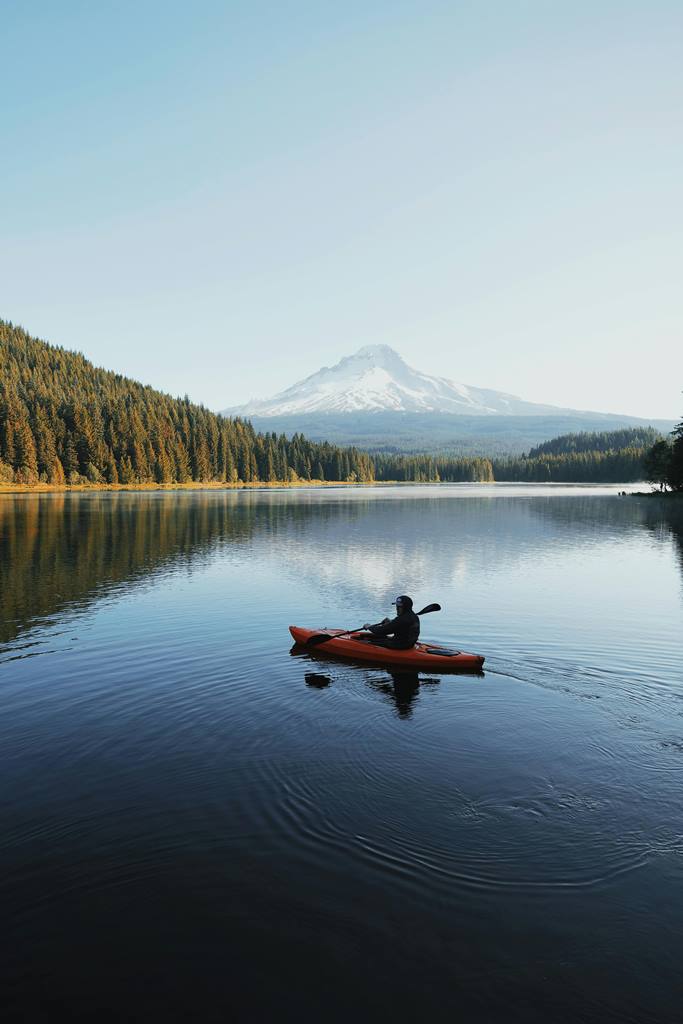
Imagine gliding through serene, snow-covered landscapes, with frosty shores and a peaceful silence surrounding you. The winter scenery is breathtaking and offers a unique perspective that summer paddling can’t provide. Plus, you’ll likely have the water to yourself since fewer people kayak in the winter, making it a truly tranquil adventure.
To enjoy winter kayaking, you need to prepare properly. Dress in layers and wear a waterproof drysuit to stay warm and dry. Don’t forget thermal gloves and a hat to protect your extremities from the cold. Always check the weather forecast and water conditions before heading out, and let someone know your plans.
Winter kayaking also calls for a bit of extra safety gear. Make sure you have a reliable life jacket, a whistle, and a dry bag for your essentials. It’s also wise to paddle with a buddy or let someone know your route and expected return time.
With the right gear and precautions, winter kayaking can be just as enjoyable as paddling in the summer. The crisp air, the stunning winter scenery, and the quiet solitude make it a rewarding experience. So, don’t pack away your kayak when the temperature drops. Embrace the cold and discover the beauty of kayaking all year round.
Winter Kayaking Clothing Tips
The key to winter kayaking is dressing right. Since you lose a lot of heat through your head, wearing a hat is crucial to avoid hypothermia and keep your ears warm. Your hands are also vulnerable, and holding a paddle with freezing fingers can ruin your trip. Thick, padded gloves are a must for winter kayaking.
For the rest of your body, layering is the way to go. Wear warm, moisture-wicking clothing that you can add or remove as needed to stay comfortable. Make sure to cover your upper body, legs, and feet well.
Capsizing is always a risk, and in cold water, it can be dangerous. Cold water quickly drains your body heat and makes swimming difficult. To stay safe, always wear a life jacket and a waterproof outer layer. These will help keep you afloat and dry if you end up in the water.
Safety is paramount when kayaking, especially in winter. Make sure you have the proper gear, including a life jacket, and always be prepared for the unexpected. By dressing properly and taking necessary precautions, you can enjoy the serene beauty of winter kayaking while staying warm and safe.
Kayaking stands out as one of the few water sports that you can enjoy all year round. Whether you’re going solo, with friends, or with family, there’s something for everyone. You can take on the challenge of white water kayaking or have a peaceful day lake kayaking to observe nature. With so many ways to enjoy kayaking, it’s easy to see why so many people find it fun. Perhaps you’ll soon discover your passion for paddling too!
Essential Kayak Gear Guide
Now that you have an idea of what equipment you need, let’s ensure you’re fully prepared for your canoe trip. Here’s a rundown of essential gear to pack for a smooth and safe adventure:
- Life jacket
- Helmet
- Sunglasses and sunscreen
- Headlamp or flashlight
- First aid kit
- Paddle
- Thick padded hat
- Gloves
- Waterproof barrels or bags
- Throw bag
- Water map
With this comprehensive gear list, you’ll be ready for any canoe trip, ensuring a successful and enjoyable experience every time!
The Bottom Line
In essence, kayaking and canoeing offer year-round excitement and tranquility, whether you’re tackling white water rapids or enjoying a serene lake. With the right gear and preparation, every trip can be a safe and memorable adventure. Embrace the water, stay prepared, and discover the joy of paddling in any season!

